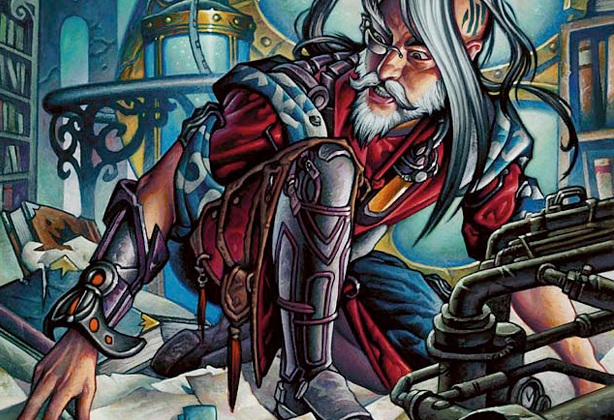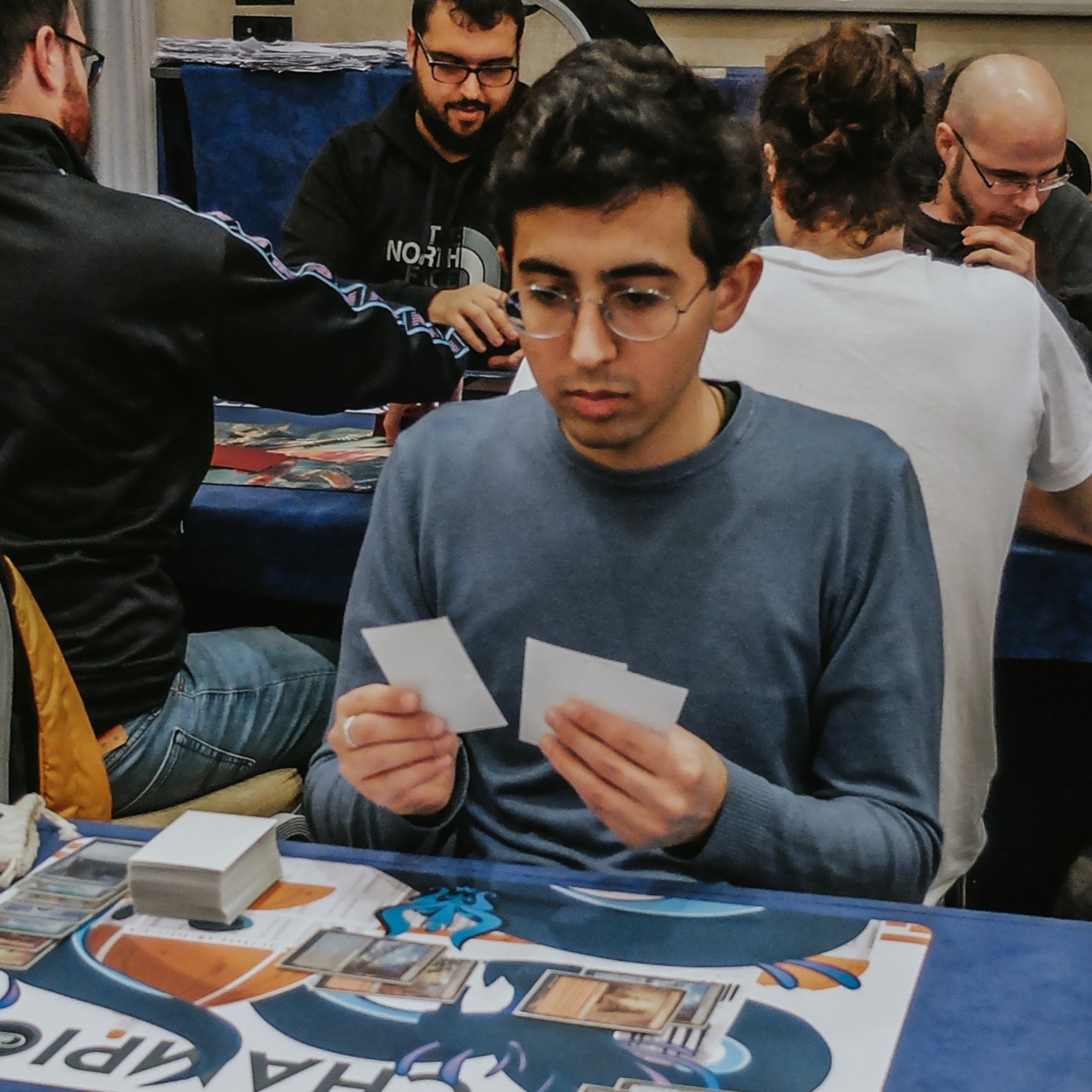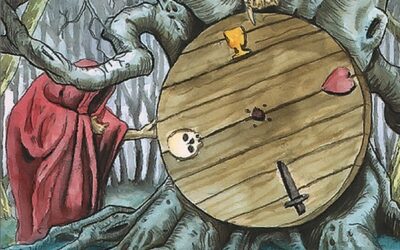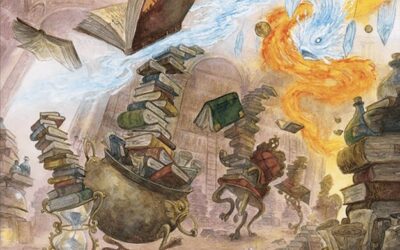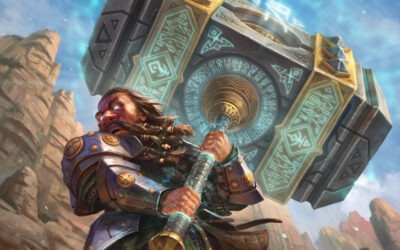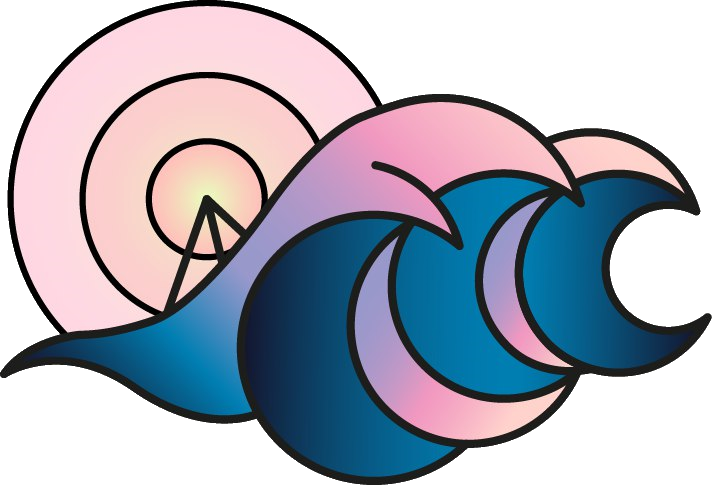Thanks to the Challenge Project, run by the Castle of Commons Discord server [https://discord.gg/U4hnkNT], we have (almost) full information about the Pauper challenge meta. As far as the Magic Online leagues go, instead, having full information will never be possible unless data is released from WotC itself. However, we can at least get a picture of the league meta by using data collected by the people who keep track of their league matches, which I’m going to do here.
In this article, I will show my methodology and talk about five Pauper metagames. Soon, I will also focus on the evolution of the meta over time and the differences between Leagues and Challenges. The data that I’m using consists of 4938 matches, spread over 22 months and recorded by 13 people: me (Walker735), apas72, HeWhoIsInTheWater, bren, Jayrod_Silva, Zimplfy/NotGood, kalko, bnoru, kalikaiz/saidin.raken, BluStalker, Calpine, pproteus and A_AdeptoTerra.
Huge thanks to all the people who contributed!
Walker735
The data that I received from bren is a special subset, because, in addition to tracking their matches, they kept track of the matchups found by content creators and by people who shared their league results on Discord. Therefore, the data technically comes from more than 13 people, even though bren’s data only covers the period between Fall from Favor’s ban and Modern Horizons 2. To express this, I’ll make a “+” follow the number of data collectors when referencing the number of people who contributed to that data set.
Data can be framed in different ways and tell different stories. What I’m showing here is shaped by my current understanding of the format, but I will be transparent about my criteria so that at least you can judge by yourself to which degree you agree with them.
I’ve broken up the last two years of Pauper into 5 segments, using B&R announcements and high-powered sets release dates as dividers, except for Double Masters release date, which was ignored because it was too close to a ban. For each segment, only decks which have at least 2% meta share in that segment will be featured in the respective pie chart. Everything else falls under the “other” category. More details about my deck categorization can be found at the end of this article.
Keep in mind that meta share doesn’t necessarily relate to power level and that league grinders usually prefer decks that lead to quick matches. Fun fact: my win rate with Elves tends to be inversely proportional to the deck’s presence in leagues.
Section 1: the Five Eras
From the banning of Arcum’s Astrolabe (Oct 21, 2019) to the banning of Mystic Sanctuary and Expedition Map (July 13, 2020)
This meta saw a cyclical fight between blue tempo/midrange decks (Izzet Faeries, Dimir Delver, and Mono Blue Delver, for a total of 18.6% meta share), Flicker Tron (9.6%), and Boros midrange decks (Boros Monarch and Bully, for a total of 9.9%). It was commonly held that the blue decks beat Tron, which beat Boros decks, which beat the blue decks. As you can see by the disproportionate amount of blue decks, this rock-paper-scissors mechanism wasn’t perfect, but the format was fairly balanced, and many tier 2 decks were allowed to exist and thrive. I’m not saying that there wasn’t any underlying issue, but the meta was pretty close to what I would consider a “normal” Pauper meta, as opposed to the other two pre-ban metagames that we will review: the Fall from Favor meta and the Modern Horizons 2 meta [I know that there hasn’t been any ban following MH2, but we all know that it’s coming.].
In this period, thanks to new cards (Winding Way and Crashing Drawbridge) and Caleb Gannon’s brewing efforts, Walls parted its way from Familiars, becoming an autonomous and respected figure in the metagame.
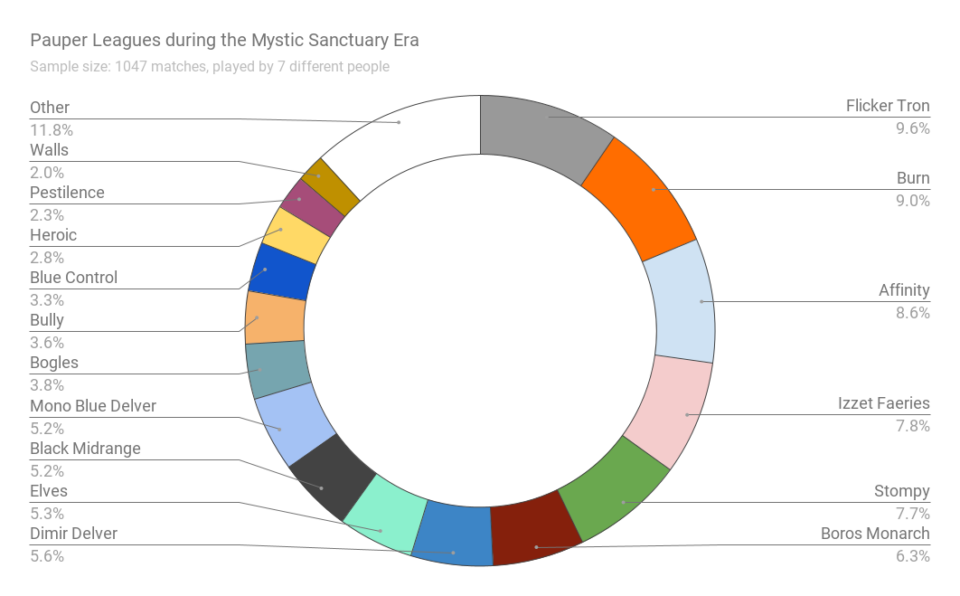
From the banning of Mystic Sanctuary and Expedition Map (July 13, 2020) to the release of Commander Legends (Nov 18, 2020)
This season originated from one of the most controversial ban announcements in the format’s history. According to the most successful Tron players, Flicker Tron benefited from Mystic Sanctuary’s ban more than it was hurt from Expedition Map’s ban. Consequently, the three archetypes system was broken and Tron ended up dominating the challenges for months.
By contrast, leagues numbers look rather healthy and diverse in this time frame. The ban’s impact on Tron (9.0%) and tempo decks (17.3%) was negligible in terms of meta share, and the format kept more or less its pre-ban shape. If we look inside the “tempo deck” conglomerate though, we can see the true legacy of the Sanctuary ban. The need for a new value engine (Thorn of the Black Rose) and the printings of Suffocating Fumes and Cast Down all contributed to the birth of a new giant: Dimir Faeries.
Meanwhile, another deck was being hit by Mystic Sanctuary’s ban: Familiars. Surprisingly, this deck’s meta share nearly triples after the banning of one of its key combo pieces. My guess is that Sanctuary Familiars was an exoteric deck, with hidden lines and convoluted combos that were hard to perform on Magic Online, so, when the deck went back to being a normal Flicker pile, it became more accessible and attracted more pilots (like me).
The most popular deck in this era is Stompy. I think that Stompy being popular in leagues is usually a good sign about format health, as it means that no deck is broken enough to be worth playing over the quick and consistent Stompy from the grinder’s point of view. But this is probably an oversimplification of how things work.
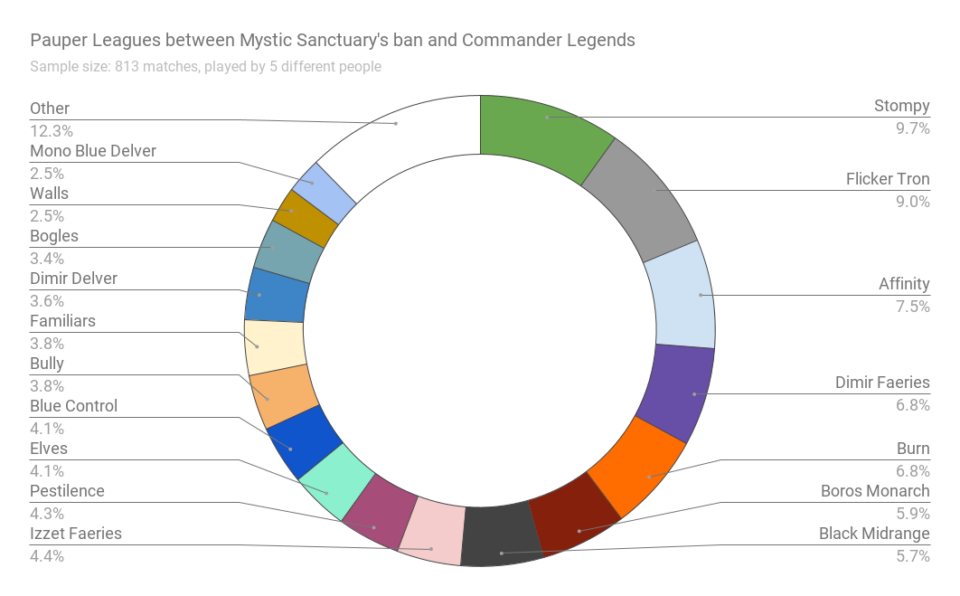
From the release of Commander Legends (Nov 18, 2020) to the banning of Fall From Favor (Jan 14, 2021)
Commander Legends was certainly one of the most impactful sets ever for Pauper. The set introduced many new cards that have shaped the format ever since they appeared, and in the first portion of the CMR season, the metagame was turned on its head.
Unsurprisingly, Fall from Favor greatly increased the blue tempo decks’ popularity, bringing them to an impressive total of 24.9% of the metagame. It was also tried with success in Affinity, but that didn’t stop Affinity from registering its lowest meta share in these two years. Experiments to put FFF in Elves, Familiars, Mono Black and other decks were also made, with less success. Faeries and Delver decks were the best shells for the card.
On the other hand, the cascade creatures made green-based Ponza decks become real contenders in the meta and gave birth to a new version of Walls. Cascade Walls and Ponza had an explosion in popularity, despite having bad Faeries and Delver matchups, likely because people simply loved playing those two brand new decks featuring cascade creatures. Between the cascade trend and the fact that blue decks had just got the cheapest monarch card of all times, midrange decks and Tron tanked in popularity.
At the same time, another old faerie predator had disappeared: Stompy. Stompy was very good against Fall from Favor and land destruction, especially, but not only, thanks to Quirion Ranger. My explanation for Stompy’s demise is that people were afraid of the newly printed Fiery Cannonade, even though the following months would’ve revealed that the card isn’t that big of an issue for Stompy in particular, which has a remarkable go-tall component.
With all these decks gone, it was up to Bogles and Heroic to try and keep faeries in check, so they increased in popularity.
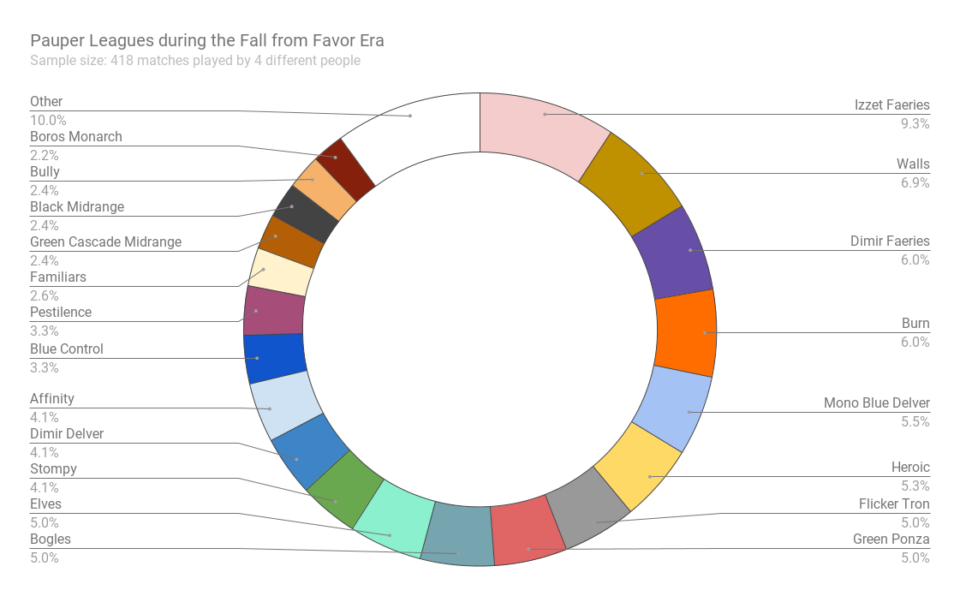
From the banning of Fall From Favor’s (Jan 14, 2021) to the release of Modern Horizons 2 (June 3, 2021)
With the banning of Fall From Favor, the format reverted to a fairly normal shape, except for the fact that it was still under the influence of Commander Legends, which in this case was a positive influence in my opinion.
Ponza and Walls were redimensioned, but they kept their presence and role in the metagame, preventing Tron from recovering its past glory (remember that I’m just talking about popularity here). Meanwhile, green-based cascade decks became the most popular kind of midrange in the format.
With Strixhaven’s release, blue-based control decks were turned into control-combo decks featuring Serpentine Curve, and a Goblin Combo deck featuring First Day of Class was born.
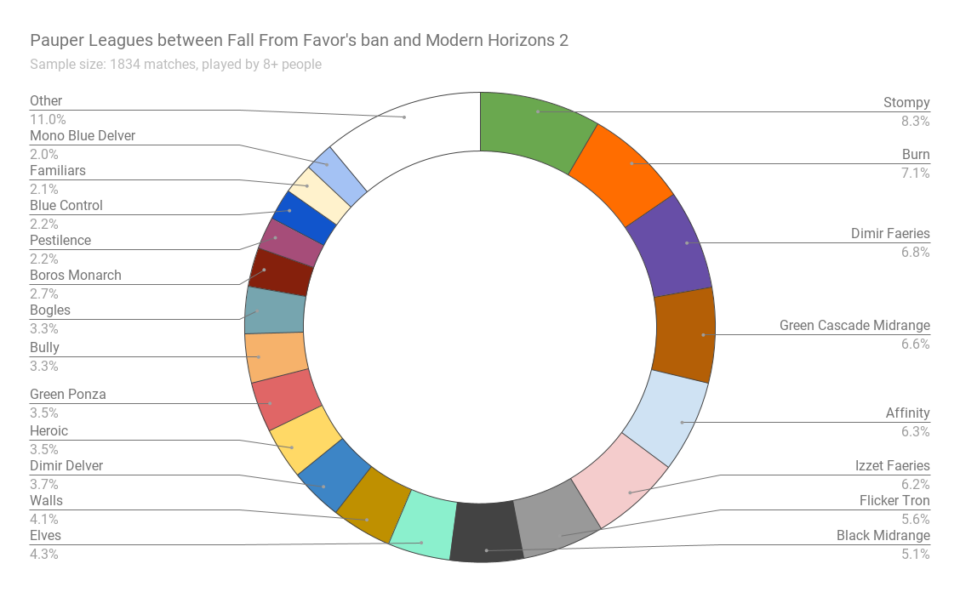
The Modern Horizons 2 meta (June 3, 2021 – today)
MH2 caused the biggest shakeup to date in the 2 years that we’re reviewing here.
Grapeshot and Empty the Warrens were banned in 2013, and no good Storm deck has existed ever since. Now, Chatterstorm has brought Storm to an astonishing 16.8% of meta share, beating by far the 9.7% that we registered for Stompy during the post-Sanctuary era, which was the highest number reached by a single deck yet. And yet, Affinity manages to be even more popular than that, with its 20.7%, thanks to Sojourner’s Companion and indestructible artifact duals. Dimir Delver and Dimir Faeries (total 12.6%) are considered to constitute together the third pillar of this format, but they aren’t nearly as popular as Storm or Affinity.
The only other deck that has experienced substantial growth is Jeskai Ephemerate, which has finally found a new way to fix its mana through Cleansing Wildfire, thanks to the new indestructible dual lands. An honorable mention goes to Soul Sisters, which was rediscovered after the release of Adventure in the Forgotten Realms, thanks to Celestial Unicorn. It isn’t popular enough to appear in the chart, but it went from 0% to 1.8%, which is a very good accomplishment, even though it probably isn’t going to last for long.
Every other deck shrunk, or simply disappeared because it can’t keep up with one or more among the three format pillars; the most glaring example being Stompy, which used to be the most popular deck just in the previous meta, and is now reduced to a humble 0.6%. By the way, most of its sightings come from the early stages of the new metagame. The current situation is likely even worse for Stompy.
My takeaway is that if there have been times where you could enter a league hoping to dodge the best deck, this is not one of them. You can’t enter a league with a nice deck that loses to Storm or Affinity, willing to accept the loss if I run into it, because expecting to have a good result would be unrealistic, given those decks’ omnipresence.
I will admit that this meta has one positive element, which is how the matchups between the three top decks are very balanced, unlike the matchups between the three old pillars of the Sanctuary era, which were quite polarized. But at the same time, the gap between tier 1 decks and tier 2 decks has never been so wide, and too many decks have disappeared. The situation is ridiculous and I’m sure that action will be taken as soon as someone at Wizards of the Coast will seriously look into it.
I would also like to point out that Faeries is the only archetype that keeps being a top strategy over the years, despite regularly receiving bans and powerful cards being printed for other archetypes. While banning Chatterstorm is the priority, I honestly think that banning something from the blue tempo decks is more important than banning something from Affinity. Enough about bans though. The aim of this article is just to provide some context for the data, and meta share alone doesn’t provide sufficient information to seriously talk about format health.
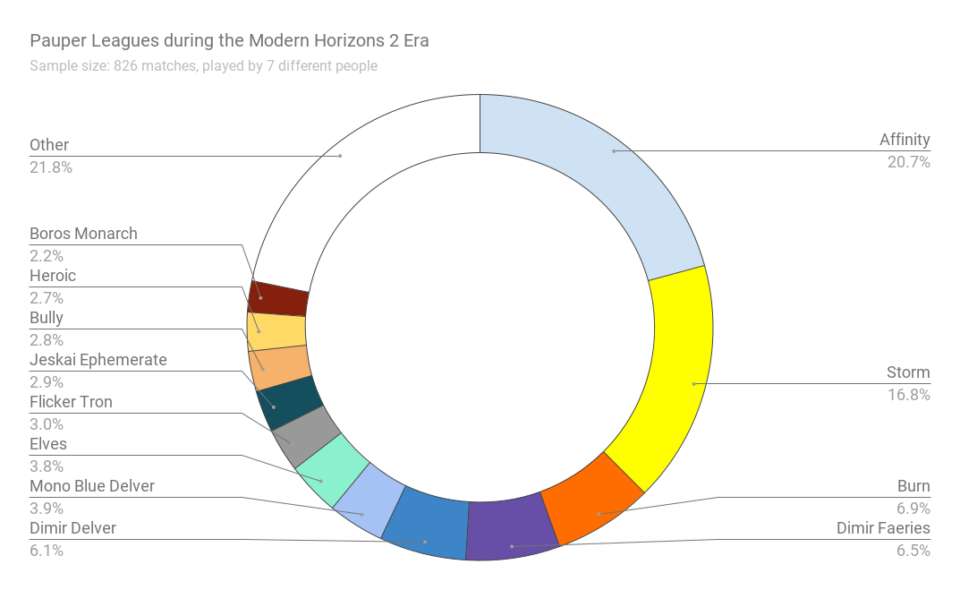
Section 2: Deck Categorization
As I mentioned, I’ve gathered data from different people. Of course, each one of them had their way to classify decks, like I have mine. So, for the purpose of this roundup, I had to translate everything into a coherent system. I opted for having broad concepts, rather than minute distinctions, mainly for two reasons: (1) it makes the data more readable, and (2) it lowers the chances of running into data that can’t be translated. For example, let’s say that I consider Jeskai Affinity a different deck from Grixis Affinity; then, I run into some data that only mentions “Affinity”. How do I translate it?
On the other hand, the archetypes couldn’t be too broad, as that would have resulted in a loss of critical information: it’s a tough balance.
These are the most relevant choices that I’ve made:
“Affinity” includes every version of Affinity, regardless of what colors they play. But it doesn’t include metalcraft decks like Brute Squad, which have their own category, that you don’t see simply because they never reached 2% of meta share.
“Izzet Faeries” includes both the classic version and the one that runs Delver of Secrets in addition to the faerie package. Dimir Faeries is distinct from Izzet, and Dimir Delver (which includes Dimir Angler) is distinct from Dimir Faeries, because:
- They are more established decks compared to the countless versions of Affinity or other archetypes (is the Affinity that splashes black for Deadly Dispute as Grixis as the one that splashes for Disciple of the Vault?).
- It’s interesting to see the different behaviors of these decks in different metagames.
- I had the option to do so. Everybody distinguishes them when they track their matches. There is only one exception to this statement. Apas72 didn’t make any distinction between Dimir Faeries and Dimir Delver in the FFF era (only in that period). So I had to artificially split his Dimir category in Faeries and Delver, with a 60-40 proportion based on data from the other 3 sources about that time frame.
“Stompy” includes both the classic version and the Bayou Groff aristocrats-ish version.
“Black Midrange” means “black-based midrange decks” and it includes things like Mono Black Devotion, Rakdos Midrange and even things like Mono Black Corrupt, even if it isn’t a midrange deck strictly speaking, but it doesn’t include Pestilence. In hindsight, maybe I should’ve grouped Mono Black Corrupt with Pestilence, but don’t worry: I can assure you that it wouldn’t have changed much, as Mono Black Corrupt has always been almost inexistent.
“Elves” includes both the Simic and the mono green version.
“Mono Blue Delver” includes various versions of the deck, like the one with Quandrix Pledgemage and even some other weird variations, more focused on the beatdown plan.
“Boros Monarch” includes both the classic version and the ones that splash black to any degree.
“Bully” includes some other white-based fringe token strategies in addition to the classic version, but it’s distinct from White Weenie.
“Blue Control” includes Goblin Wizardry decks, Serpentine Curve decks, Mystical Teachings decks, Mono Blue deserts and other blue-based control decks. It also includes Rat-lock. I was hesitant about including a Flicker deck in this category, but at the end of the day, to belong to this category, it doesn’t matter too much which endgame you choose, as long as you execute a control gameplan.
“Pestilence” includes both the midrange version with Kor Skyfisher and the Control version with Pristine Talisman.
“Walls” includes both the Combo and the Cascade versions. This decision is probably the one that bothers me the most, as these two decks have fairly different game plans and matchup spreads. But I wasn’t always able to distinguish the two archetypes in the raw data, and Combo Walls is basically extinct anyways since the printing of the Cascade creatures.
“Familiars” includes both the classic Azorius version and the one that splashes for red, as well as the Rainbow version with Utopia Sprawl.
“Green Ponza” includes every green-based land destruction strategy, from mono green to Jund, but the most common one is Gruul.
“Green Cascade Midrange” includes all the green-based cascade piles, like Jund, Gruul or Sultai.
“Storm” includes all versions of Storm with Chatterstorm as win condition. But keep in mind that the Izzet version, the Gruul version and the Rakdos version with Street Wraith are all extinct, and the overwhelming majority of Storm decks is made by the Rakdos Relay version.
“Jeskai Ephemerate” includes a few blue-based Ephemerate piles, such as Geskai, with Kor Skyfisher and Abundant Growth, but the most common version is the one with indestructible duals and Cleansing Wildfire.


